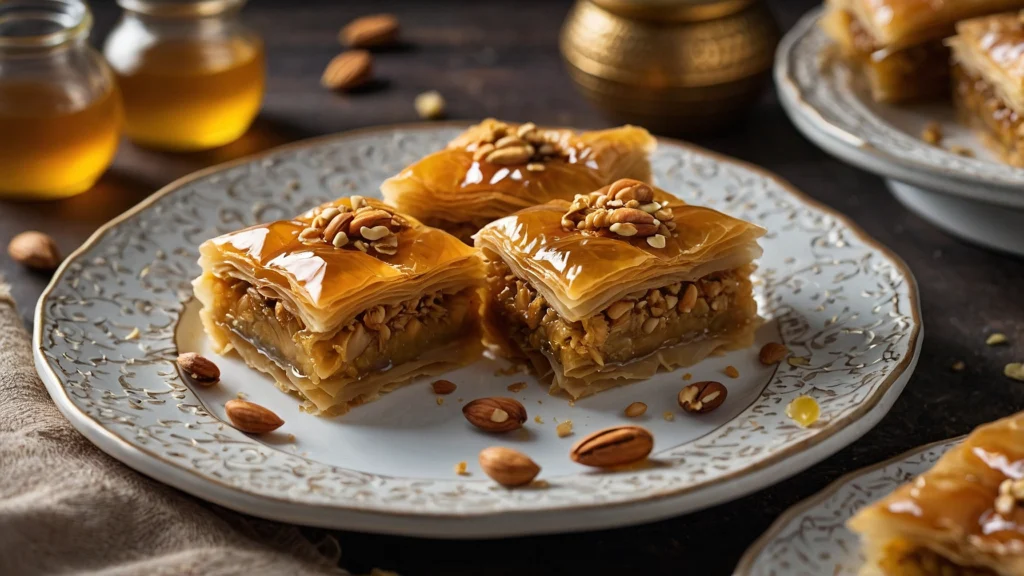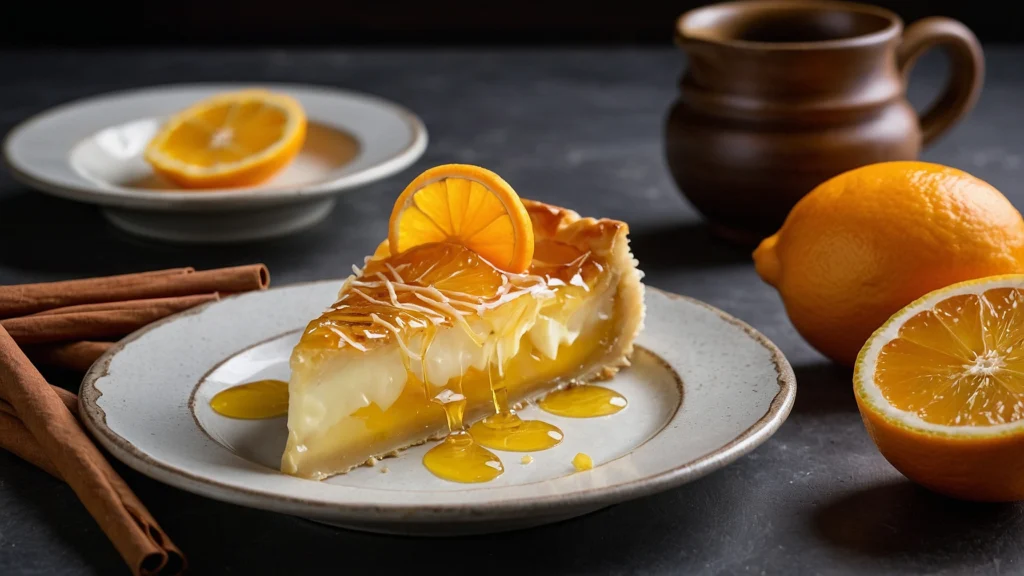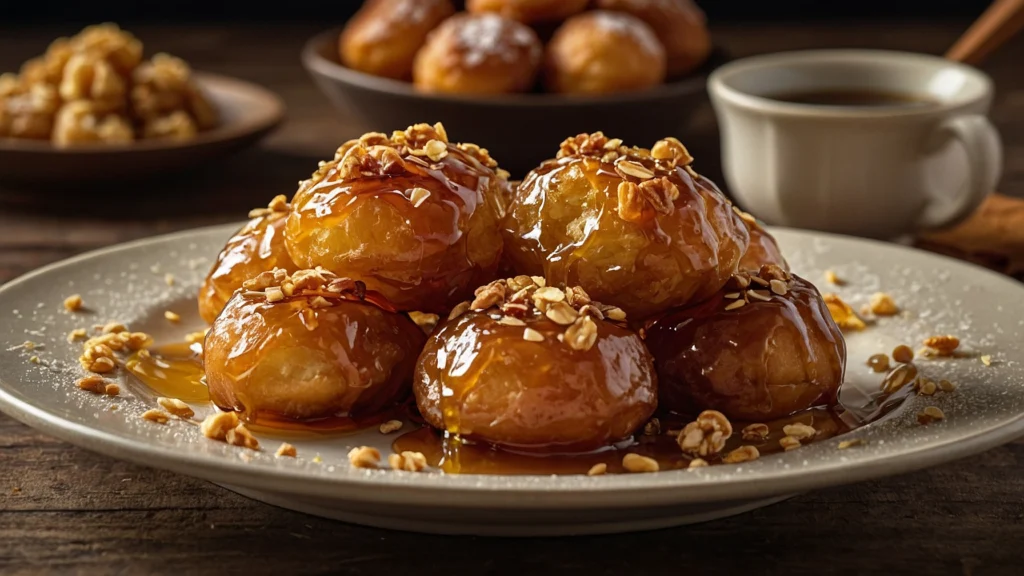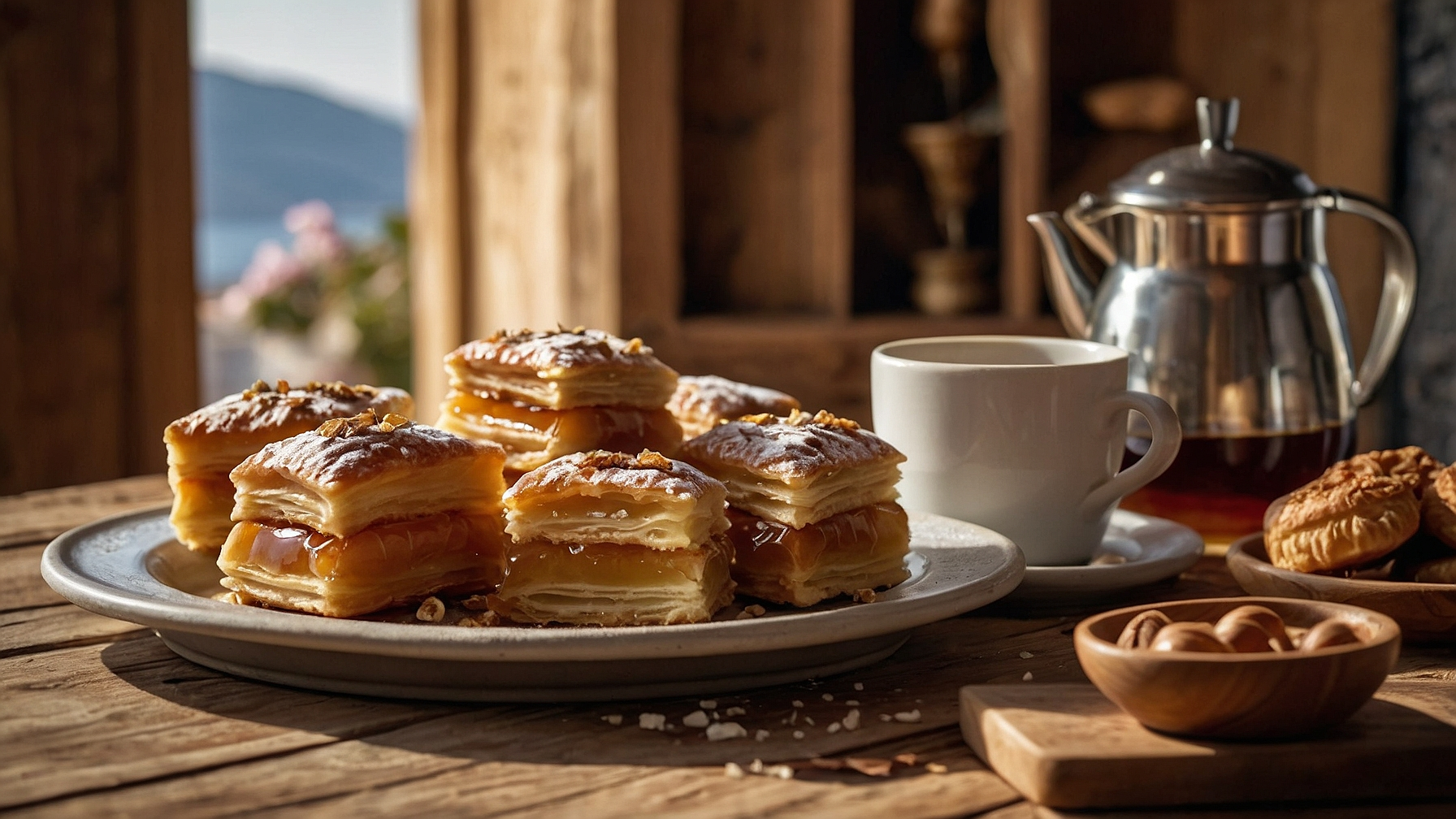Greek desserts are more than just delicious treats. They are a celebration of Greek culture and history. Made with simple ingredients like honey, nuts, and phyllo dough, they have been loved for centuries. Moreover, each dessert tells a story through its unique flavors and textures.
If you’re curious about these desserts, try making some yourself. In addition, explore our authentic Greek dessert recipes for simple and tasty ideas. From Baklava to Galaktoboureko, there’s something for everyone.
Table of Contents
Why Are Greek Desserts So Special?
Greek desserts are celebrated for their bold flavors and natural ingredients. The unique use of honey as a sweetener, as opposed to refined sugar, imparts a golden, rich flavor that is instantly recognizable. This shift in sweetness is one of the key elements that set Greek desserts apart from those of other cultures. Spices like cinnamon, cloves, and nutmeg contribute warmth and depth to the flavor profile, making these desserts a perfect balance of sweetness and spice.
What truly elevates these sweet creations, however, is their role in Greek culture. Desserts are deeply woven into Greek traditions, often making appearances during significant occasions like weddings, religious holidays, and community celebrations. They bring people together, encouraging shared moments of joy and festivity. For Greeks, a sweet treat isn’t just about flavor—it’s about connection and tradition.
If you’re looking for more breakfast inspiration, don’t forget to explore our sweet breakfast recipes for a perfect start to your day.
Famous Greek Desserts You Must Try
Greek desserts come in many forms. Some are crunchy, others are creamy, and many are soaked in sweet syrup. For instance, here are a few popular ones that you should try.

Baklava
Perhaps the most famous Greek dessert, Baklava is made of crispy layers of phyllo dough, filled with crushed nuts, and soaked in a fragrant honey syrup. The result is a sweet, nutty, and crunchy indulgence that has become synonymous with Greek cuisine.
What Makes It Unique: The delicate, flaky texture of the phyllo dough combined with the rich, nutty filling makes Baklava a multi-textured treat that’s hard to beat.
Origins: Although its origins lie in the Ottoman Empire, Greece has perfected this dessert, adding its own unique touch. The Greek version is often lighter, with a more pronounced honey flavor.
Perfect Pairing: Enjoy this iconic dessert with a cup of strong Greek coffee or a scoop of vanilla ice cream for a delightful contrast of flavors.
Galaktoboureko

A creamy custard pie wrapped in golden, flaky phyllo dough and soaked in a sweet syrup, Galaktoboureko is a crowd favorite. Its smooth, semolina-based custard filling is complemented by the crisp exterior, creating a comforting and satisfying dessert.
Why People Love It: The rich, comforting custard is made with semolina, a key ingredient that gives it a delightful texture and depth of flavor.
Perfect Pairing: A cup of hot tea or coffee is the ideal accompaniment to this dessert, enhancing its richness and adding balance to the sweetness.
Loukoumades

These delightful, small doughnuts are deep-fried to perfection and drenched in honey syrup. Crispy on the outside and soft on the inside, Loukoumades are a perfect sweet snack that is often served at festive gatherings.
Where You’ll Find Them: Loukoumades are a favorite during festivals and family celebrations, making them a part of many joyous occasions.
Add More Flavor: Sprinkle with cinnamon, crushed walnuts, or drizzle with chocolate sauce for a personalized touch.
Melomakarona
Melomakarona are soft, spiced cookies made with olive oil, honey, and a mix of warm spices. These cookies are soaked in a light syrup and topped with crushed walnuts, offering a taste of both sweetness and heartiness.
Why They’re Popular: These cookies are particularly enjoyed during Christmas, where they are prepared as gifts or served at festive tables.
Healthier Option: Thanks to the use of olive oil instead of butter, Melomakarona offer a lighter alternative to more traditional cookies while retaining their rich flavor.
Kourabiedes
Kourabiedes are buttery, crumbly almond cookies that melt in your mouth. Coated in a dusting of powdered sugar, they are a festive delight that’s often served during weddings and Christmas.
When to Enjoy Them: These cookies are a staple of Christmas celebrations and weddings, where they are shared among friends and family.
Tip for Success: Use high-quality butter to ensure the cookies turn out rich and flavorful.
Regional Favorites in Greek Desserts
Greek desserts vary by region. For example, each area has its own special treats, influenced by local ingredientAs with many countries, Greek desserts vary from region to region, each reflecting local traditions and available ingredients. These regional specialties offer a glimpse into the diverse cultural influences across Greece:
Rizogalo: This creamy rice pudding is infused with cinnamon and vanilla. Simple yet comforting, it’s a dessert that has been enjoyed for generations.
Pasteli: A traditional sesame and honey bar, Pasteli is a healthy, chewy snack that dates back to ancient Greece. It’s a great source of energy, often enjoyed by athletes or travelers.
Looking for a modern twist? Try our ricotta dessert recipes for creative ideas to elevate your sweet treats.
The History of Greek Desserts
Greek desserts have a rich and long history that reflects the cultural evolution of the region. From ancient Greece to the Byzantine Empire and the Ottoman period, these desserts have evolved over centuries, incorporating different influences along the way.
Ancient Roots
In ancient Greece, honey was highly revered and considered a gift from the gods. Many of the early Greek desserts used honey as a natural sweetener, providing a distinct and rich taste that still defines many of today’s treats. Pasteli, a honey and sesame bar, and Halva, a dense, sweet treat often eaten during fasting, are among the oldest Greek desserts.
Celebrations and Traditions
Greek desserts are essential for celebrations. They are served at weddings, baptisms, Easter, and Christmas. Each dessert has a special meaning. For instance, Melomakarona symbolizes joy and abundance, while Kourabiedes are a symbol of happiness.
Making Greek Desserts at Home
You can enjoy Greek desserts at home with just a few basic ingredients. Here’s what you’ll need to get started.
Must-Have Ingredients
- Phyllo Dough: The base for many Greek pastries like Baklava and Galaktoboureko.
- Honey: Adds a natural sweetness to most desserts.
- Nuts: Walnuts, almonds, and pistachios are commonly used.
- Semolina: A key ingredient for making custards and cakes.
- Spices: Cinnamon, cloves, and nutmeg are essential for authentic flavors.
Tools to Use
If you’re inspired to try making Greek desserts at home, it’s easier than you might think! With a few essential ingredients and some basic kitchen tools, you can recreate these delicious treats in your own kitchen.
Must-Have Ingredients
- Phyllo Dough: A must-have for making Baklava and Galaktoboureko.
- Honey: The primary sweetener in most Greek desserts.
- Nuts: Walnuts, almonds, and pistachios are frequently used.
- Semolina: Essential for making custards and cakes like Galaktoboureko.
- Spices: Cinnamon, cloves, and nutmeg are key for authentic flavor.
Tools to Use
- A pastry brush to layer phyllo dough.
- A zester to add citrus zest to desserts.
- Non-stick baking pans for easy cleanup.
Pro Tips for Success
- Work quickly when using phyllo dough to avoid it drying out.
- Pour cool syrup over hot desserts to maintain their crisp texture.
- Allow desserts to rest for a few hours before serving to let the flavors meld together.
Modern Twists on Traditional Desserts
You can give classic Greek desserts a modern twist by adding new flavors or ingredients. For example, here are some ideas:
- Chocolate-Dipped Loukoumades: Drizzle melted chocolate over the doughnuts for a rich flavor.
- Baklava Cheesecake: Combine the flaky layers of Baklava with a creamy cheesecake base.
- Citrus Halva: Add orange or lemon zest for a fresh, zesty flavor.
Frequently Asked Questions (FAQs)
What are the healthiest Greek desserts?
Pasteli and Halva are some of the healthiest options. They use natural sweeteners like honey and include nutritious ingredients like nuts and sesame.
Can Greek desserts be made vegan?
Yes! Many desserts, like Halva and some versions of Rizogalo, are naturally vegan. Alternatively, you can substitute plant-based ingredients for recipes that use dairy.
What makes Greek desserts unique?
Greek desserts are unique because of their simplicity. Above all, they use natural ingredients like honey, nuts, and spices to create bold flavors. They are also less sugary compared to many other desserts.
Why You Should Try Greek Desserts
Greek desserts are more than just food. In short, they are a way to celebrate traditions and connect with loved ones. Whether you’re enjoying the crispy layers of Baklava or the creamy richness of Galaktoboureko, these desserts offer something special.
If you’re ready to get started, check out our dessert cup recipes. Finally, with these recipes, you can bring the sweet flavors of Greece into your kitchen.
